Physical Address
304 North Cardinal St.
Dorchester Center, MA 02124
This chapter begins with a brief review of the anatomy of the spine. Imaging techniques are then discussed, followed by the normal imaging appearance of the spine on magnetic resonance (MR) imaging and computed tomography (CT). We then consider degenerative diseases of the spine. These common diseases may manifest as localized back pain, radiculopathy (pain radiating in a spinal root distribution), or myelopathy (signs of spasticity, increased tone, and increased reflexes). The radiologic differential diagnosis of spine lesions is based on localizing the lesion to a particular space.
A brief word concerning terminology. Understanding the terminology used in localizing spinal lesions is critical in framing your differential diagnosis as well as presenting yourself as a knowledgeable radiologist. So a little repetition would not hurt. The anatomic algorithm historically used by radiologists was predicated on myelographic interpretation as to whether lesions were extradural, intradural extramedullary, or intramedullary. Intramedullary lesions are indigenous to the spinal cord, tend to expand it, and narrow the subarachnoid space. They include spinal cord tumors such as astrocytoma, ependymoma, and spinal cord metastases, as well as nonneoplastic lesions such as syringohydromyelia, infections, and inflammation such as transverse myelitis, acute disseminated encephalomyelitis, or cord infarcts. Intradural extramedullary lesions are lesions outside the spinal cord but within the thecal sac. These include meningioma, neurogenic tumors, subarachnoid seedings, or vascular mass lesions such as arteriovenous malformations or varices. Those which are intradural but extramedullary (outside the cord) expand the subarachnoid space on the ipsilateral side (producing a meniscus) and shove the cord over to the contralateral side. Obviously, intradural lesions below the termination of the spinal cord are extramedullary. Lesions that compress or are intrinsic to the cord often produce myelopathy, whereas those which compress and irritate the roots cause radiculopathy.
Extradural lesions occur outside the thecal sac and may originate from the adjacent paraspinal soft tissues, disk (herniated disk), disk space (epidural infection), or the vertebrae (osteophytes, primary bone and metastatic tumors). Extradural lesions are a more common cause of compression on the cord than intradural extramedullary lesions, purely by virtue of their large numbers; that is, compressive disk herniations and bone metastases are more common than intradural lesions.
Although spinal anatomy lacks the sex appeal of other anatomic sites, it does have certain features that are intriguing and may even keep your attention (SEX SEX SEX—see, got your attention!).
The Doc ordered MR of the spine
For “Painful back of 3 weeks’ time”
The HMO said,
“6 weeks in bed!”
To operate is “Medicare crime”
The bony spine is divided by region into the cervical spine containing seven vertebrae (the first two of which are rather unique and are discussed further), the thoracic spine, consisting of 12 vertebral bodies; and the lumbar spine, with five vertebral bodies. The distal spine consists of the sacrum and coccyx. The spine encases the spinal cord, which normally terminates at a variable level from approximately T12 to L2 in adults.
The spinal cord contains eight cervical, 12 thoracic, five lumbar, five sacral, and one coccygeal paired spinal nerves. These nerves are rather easily identified on CT with intrathecal contrast or high-resolution T2-weighted (T2W) MR. It is important to appreciate that C1, which is a sensory nerve, exits above the C1 and C2 interspace so that the C2 nerve exits between C1 and C2, C3 nerve exits between C2 and C3 and so on. Therefore, the C8 nerve root exits between C7 and T1. In the thoracic region, T1 exits between T1 and T2, and T12 exits between T12 and L1. In the lumbar spine the L1 root exits between L1 and L2 and so forth, so that the L5 root exits between L5 and S1. However, a funny thing happened on the way to creation. The bodies in the lumbar region became much longer. The nerve roots in this region leave the thecal sac right under the pedicle ( Fig. 15-1 ), well above the interspace. Paracentral disk herniations in the lumbar region characteristically strike the root in the thecal sac that will exit below the interspace. This is because the disk space is inferior to the same numbered exiting root at that level. Thus, an L4-5 disk herniation most often compresses the L5 root because the L4 root is already in the foramen (above the disk). Very lateral herniated disks may compress the upper root; that is, an L4-5 lateral herniation can compress the L4 root in the foramen. Larger disks can compress many roots in the thecal sac. Furthermore, disk fragments may migrate superiorly and compress the root exiting at the appropriate interspace; that is, an L4-5 free fragment can compress the L4 root or a combination of both the L4 and L5 nerve roots.

Contrast that finding with the cervical spine where a C6-7 disk herniation in the foramen injures the C7 nerve root and a paracentral one also may affect the same nerve root because of the horizontal course of the root. In the cervical region, the roots are in the lower portion of the foramen whereas in the lumbar region they are in the upper aspect of the neural foramen. In the thoracic region, disk herniations may cause myelopathic changes; however, they can also produce thoracic radiculopathy. Lesions at a given thoracic spine body level might also produce sensory symptoms one to two segments below the compression. This is because the cord ends at approximately T12 to L2 so that cord lesions result in neurologic deficits that are localized below their vertebral body anatomic location.
An anatomic variation is the conjoined nerve root, which occurs in less than 5% of patients, with L5-S1 being the most common disk space. This normal variation consists usually of two nerve roots traveling in the same dural pouch and exiting through the same or through different foramina. The problem is really the radiologist’s. She or he should not mistake the conjoined root on imaging for an epidural defect with obliteration of the thecal sac below the conjoined root.
Each spinal nerve is divided into a dorsal or sensory root and a ventral or motor root. The dorsal root ganglion is a distal dilatation of the dorsal root just proximal to its joining with the ventral root to form the spinal nerve ( Fig. 15-2 ).
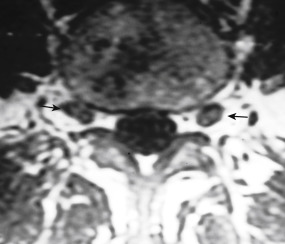
The generic vertebra is composed of the cylindric vertebral body, which contains cancellous bone with marrow and fat, covered by a thin layer of compact bone, and the vertebral arch or posterior elements, covered by a thick layer of compact bone (cortex), including the pedicles, laminae, superior and inferior facets, transverse processes, and spinous process ( Fig. 15-3 ). The vertebral configuration is modified in the different regions of the spine. The cervical vertebrae have their neural foramina between the transverse processes. The superior and inferior articular facets have joints between them (zygapophyseal) and form the articular pillar ( Fig. 15-4 ). The uncovertebral (Luschka) joints (neurocentral joints, joints of Luschka) originate from the lateral posterior portion of the vertebral body, articulate with the contiguous vertebral body, and insinuate themselves between the disk and the nerve root canal. These joints have no synovium and no hyaline cartilage, but clefts can develop in the fibrocartilage with age and degeneration. The vertebral artery enters the foramen transversarium (in the cervical transverse process, naturally) at approximately C6 and travels superiorly.
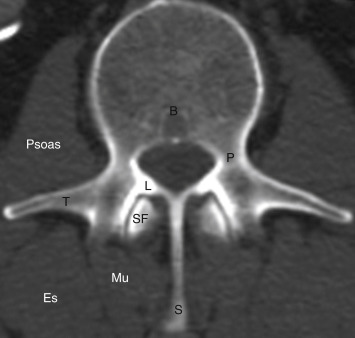
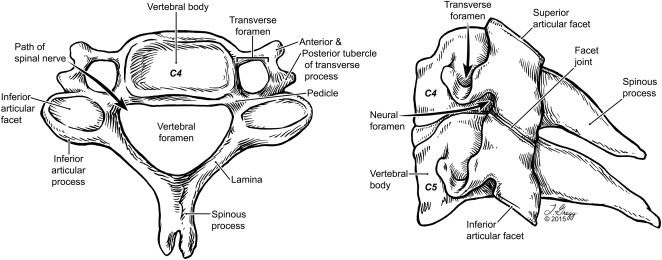
The first cervical vertebra (atlas) has no body but rather just an anterior arch connected to two lateral masses and a posterior arch ( Fig. 15-5 ). On the upper surface of the posterior arch is a groove over which the vertebral artery courses after it leaves the foramen transversarium of C1. The vertebral arteries pass through the posterior atlantooccipital membrane and course anteriorly superiorly upward through the foramen magnum. As it pierces the dura the vertebral artery may be slightly narrowed, and this caliber change can serve as a marker for the beginning of the intradural segment of the vertebral artery. The first spinal nerve exits here as well.
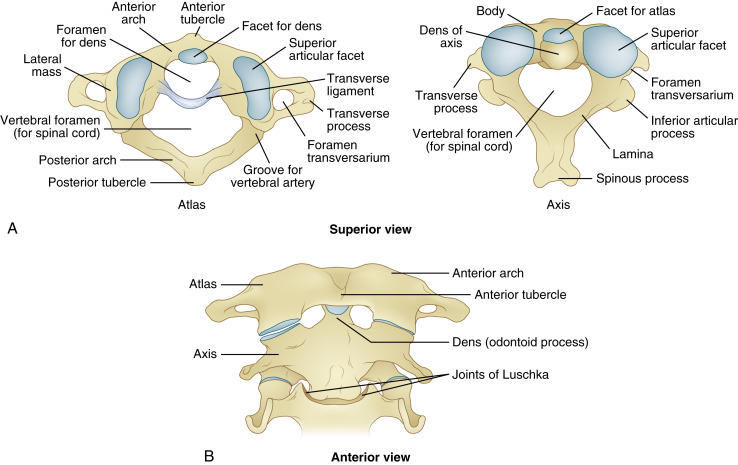
The second cervical vertebra, the axis, is unique, with a superior extension from its body termed the dens (odontoid process; see Fig. 15-5, B ). The dens represents the lost vertebral body of the atlas and is usually found fractured by residents on their first call. The articulation between the atlas and axis is composed of multiple synovial joints: one medial between the dens and the anterior arch, one on each side between the inferior articular facet of the lateral mass of the atlas and the superior facet of the axis, and multiple ones between the dens and the atlantoaxial ligaments (transverse, cruciate, and alar). Rheumatoid arthritis has a propensity for the atlantoaxial joint with pannus formation, leading to bone erosions and subluxations.
The thoracic vertebrae have an articulation on the transverse process for the rib and no foramen transversarium, whereas the lumbar vertebrae have neither a foramen transversarium nor a facet for the rib articulation. The lumbar vertebral articulations are composed of the lumbar disk and two facet joints posteriorly. The lateral recess of the lumbar spine is in the anterolateral portion of the spinal canal, with boundaries consisting of the posterior margin of the vertebral body and disk anteriorly, the medial margin of the pedicle laterally, and the superior articular facet, the medial insertion of the ligamentum flavum, the lamina, and the pars interarticularis posteriorly ( Fig. 15-6 ).
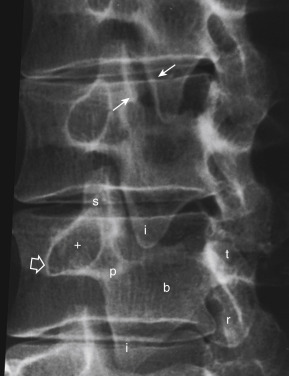
The diskovertebral complex is composed of three components: the cartilaginous endplate, annulus fibrosis, and nucleus pulposus. The endplate consists of a flat bony disk with an elevated rim (attached ring apophysis), which produces a central depression in the endplate occupied by hyaline cartilage.
The annulus fibrosus surrounds the nucleus pulposus (the remnant of the notochord). The nucleus is eccentrically located near the posterior surface of the disk. The lamellae of the annulus are fewer in number, thinner, and more closely packed posteriorly than anteriorly. This anatomic arrangement may account for the propensity for posterior herniation. The external fibers of the annulus are connected to the bone of the vertebral bodies by Sharpey fibers, which usually cannot be distinguished by imaging. Annular fibers also merge with both anterior and posterior longitudinal ligaments. Important ligaments of the vertebral column are (1) the anterior longitudinal ligament, running along the anterior aspect of the vertebral bodies; (2) the posterior longitudinal ligament, running along the posterior aspect of the vertebral bodies anterior to the thecal sac; (3) the ligamentum flavum, connecting the laminae and extending from the midline laterally to the facets; and (4) the interspinous ligament, joining the superior portion of the spinous process below to the inferior portion of the spinous process above and meeting the ligamentum flavum in the midline ( Fig. 15-7 ). The facet joints also help stabilize the spine and may be yet another contributor to spinal stenosis. There are also small ligaments in the neural foramen, which may play a role in foraminal stenosis.
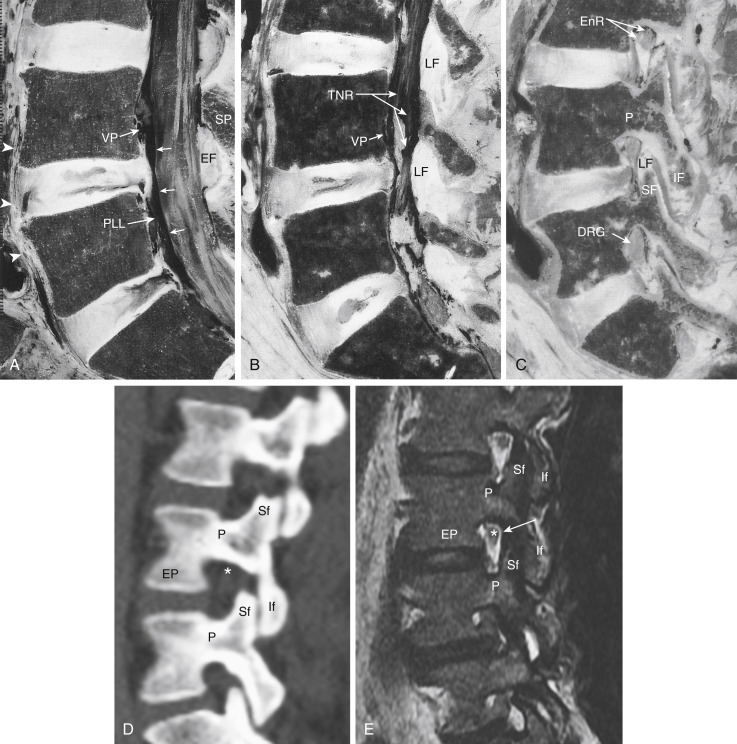
The spinal cord extends from the medulla oblongata, at the level of the upper border of the atlas, to T12 to L2, where it terminates in the conus medullaris. At the apex of the conus, continuous with the pia mater (i.e., “the tender mother”), is the filum terminale, which descends initially in the thecal sac and then becomes covered with adherent dura as it leaves the thecal sac to insert in the coccyx. The cauda equina emanates from the conus medullaris and contains the nerve roots of the lumbar and sacral nerves. The spinal cord has two enlargements in its course, one in the cervical region from approximately C4 to approximately T1 and the other in the lower thoracic region from approximately T9 to T12. Do not mistake these normal expansions for a pathologic process; otherwise you will need a return ticket to your board examination. These enlargements correspond to the locations in the cord that supply the spinal nerves for the upper and lower extremities.
The blood supply to the spinal cord depends on the particular location ( Fig. 15-8 ). In the cervical region the anterior spinal artery is formed by branches that originate from the vertebral arteries just before joining the basilar artery. The anterior spinal artery supplies the anterior two thirds/majority of the spinal cord including the anterior column of the central gray matter, the corticospinal, spinothalamic, and other tracts. In addition, paired posterior spinal arteries originate from the vertebral arteries and supply the dorsal portion of the cord; that is, the posterior columns and the posterior horn of the central gray matter. These two arterial systems do not usually have significant anastomoses between them and can lead to different myelopathic cord syndromes when compromised ( Table 15-1 ). The anterior spinal artery is in the midline whereas the posterior spinal arteries lie off the midline ( Fig. 15-9, B ). The anterior and posterior spinal arteries rarely originate at the same level. The caliber of the anterior spinal artery at a particular spinal level is proportional to the metabolic demands of the spinal gray matter.
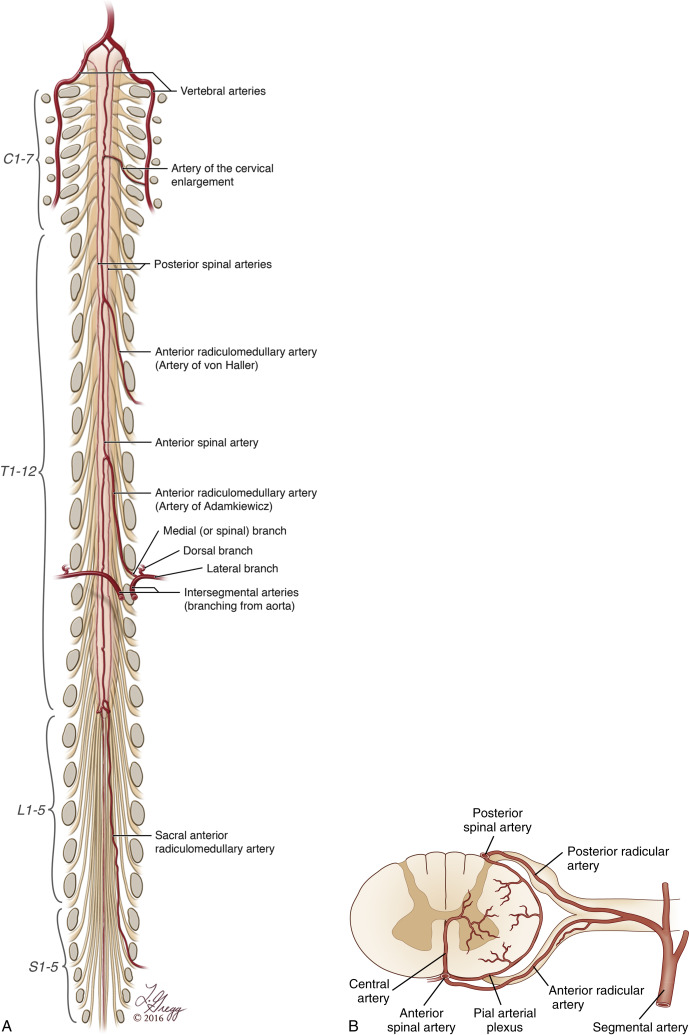
| Syndrome | Part of Cord Affected | Manifestations | Less Common Manifestations | Typical Lesion |
|---|---|---|---|---|
| Anterior spinal artery syndrome | Anterior 2/3 cord bilaterally | Bilateral motor loss and pain and temperature sensation loss | Hypotension, sexual dysfunction | Cord infarct (ASA) |
| Incomplete ASA syndrome | Just anterior horn cells | Paraplegia | Painful diplegia | Cord infarct (ASA) |
| Posterior spinal artery syndrome | Posterior column injury | Loss of proprioception, vibratory sense, total anesthesia at level of injury | Mild weakness, rarely bilateral | Cord infarct (PSA) |
| Brown-Sequard syndrome | Hemicord injury | Ipsilateral hemiparesis and loss of proprioception, contralateral loss of pain and temperature | Demyelinating diseases | |
| Cauda equina syndrome | Conus, cauda equina injury | Back pain, saddle anesthesia, bowel and bladder dysfunction with incontinence, sexual dysfunction | absent anal reflex, weakness in the legs, gait disturbance | Compression by bone/disk pathology |
| Central cord syndrome | Central cord | Bilateral loss of pain and temperature and motor control | Bladder dysfunction, urinary retention | Trauma, cervical spondylosis, cardiac arrest, hypotension |
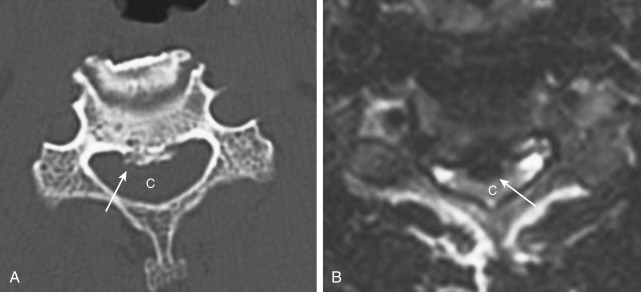
At the C3-4, C5-6, and C7-T1 levels, radicular feeders from the vertebral, ascending cervical (anterior to the transverse process), and deep cervical (posterior to the transverse process) arteries anastomose with the spinal arteries. The radicular feeders enter the thecal sac through the intervertebral foramina and divide into the anterior and posterior branches coursing with the nerve roots. Because they follow the nerve root, the spinal arteries have a sharper angle in the lumbar region than in the cervical region. However, not all spinal nerves have radicular arteries. The cervical and upper two thoracic levels comprise one vascular territory. The midthoracic region T3-T7 is supplied by intercostal branches from the aorta, branches of the supreme intercostal arteries from the subclavians, and lumbar arteries. This region may have a tenuous blood supply. The lower thoracolumbar region to the filum terminale is supplied by the artery of Adamkiewicz. It is commonly located on the left side between T9 to L2 (85% of the time) and T5 to T8 (15% of the time). It enters the spinal canal with the nerve roots and makes a characteristic hairpin loop, giving off a small superior branch from the apex of the turn and a large descending branch, which supply the anterior spinal cord and anastomoses with the posterior spinal arteries in the region of the conus medullaris.
Uncommonly, an artery named the artery of Lazorthes arises from the common or internal iliac arteries and accompanies one of the sacral roots of the cauda equina to supply the conus medullaris. The venous blood supply is comparable to the arterial blood supply with a variable amount of anterior and posterior spinal veins running with the spinal arteries.
Although imaging techniques vary, important concepts in the spine should be appreciated. These generalizations hold true for the vast majority of situations encountered, regardless of the type of equipment available. Currently, MR is the technique of choice in most situations. However, CT, myelography, and myelography supplemented by CT (myelo-CT) all have roles in particular situations and with particular surgeons. As Sam Walton once said: There is only one boss. The customer. And he can fire everybody in the company from the chairman on down, simply by spending his money somewhere else…like on a DI book.
Dollar for dollar, MR is the best single method for imaging the spine. Complete MR examination requires an excellent sagittal image. Take care to scan from neural foramen to neural foramen with thin sections, with the minimum interslice gap that your particular instrument permits. This sagittal sequences should include T1-weighted imaging (T1WI), T2WI, and short tau inversion recovery (STIR) scans to assess for disk/endplate/body/ligamentous signal abnormalities. Assess the foramina for bony constriction and the normal fat and nerves both in the axial and sagittal plane. The axial plane, because of the oblique orientation of the neck foramina, is better for such an evaluation in the cervical region (unless you play with oblique sagittal scans). In the lumbar region, the foramina have a vertical orientation and are filled in part with fat so they are well visualized in the sagittal plane. The nerve root is in the superior portion of the foramen under the pedicle in the lumbar zone. Lesions obliterating the fat are easily detected on T1WI. These include lateral disk herniations, facet joint hypertrophy, neurofibromas, soft tissue from inflammatory changes, postoperative scar, and spondylolisthesis.
In the cervical region, thin-section axial images are also necessary. A thin section low flip angle volumetric acquisition through the cervical spine enables sections of 1.5 mm or less with contrast such that the cerebrospinal fluid (CSF) is high signal, disk material is intermediate signal, and osteophytes are low signal intensity ( Fig. 15-10 ). Look for osteophytic compression of the roots or impingement on the spinal canal. Being able to distinguish a dark osteophyte from a brighter disk is critical—otherwise you default to the lazy “disk-osteophyte complex” phrase that plagues our specialty. Disk herniations are amenable to discectomies…osteophytes are not…and require shaving…distinguish between them or else go do an MSK fellowship instead of neuroradiology.

Gradient echo MR may tend to exaggerate foraminal or bony canal stenosis of the spine, and what appears as high-grade or complete blocks on MR may not be as severe on myelography, CT myelography, or T1WI. Fast spin echo (FSE) T2WI is the routine supplemental technique used for imaging the CSF, spinal cord, and nerve roots. One advantage for FSE imaging derives from its relative insensitivity to susceptibility effects compared with gradient and conventional spin echo techniques. Thus, spinal osteophytes are not as exaggerated on sagittal images as with the other techniques and there is better visualization of the extent of thecal sac compression, cord compression, and intrinsic cord pathology. Short tau inversion recovery images are excellent for detection of ligamentous injury and bone edema that otherwise is lost on FSE T2WI where fat and edema are both bright in the bone.
Diffusion-weighted/tensor imaging of the spinal cord has a role in the diagnosis of ischemic, inflammatory, traumatic, and demyelinating lesions of the spinal cord as well as studying the normal maturation of the cord in pediatric patients. Cord infarcts are readily detected. DTI may show that astrocytomas disrupt fibers whereas ependymomas are prone to displacing fibers.
Although MR is the best technique for demonstrating spinal cord compression, it cannot definitively judge whether a particular lesion will produce a complete block on myelography. This may be less of an issue with new imaging techniques, because treatment protocols are directed more toward lesions as opposed to the consequences of the lesions (the myelographic block). Indeed, the “block” has gone the way of the typewriter—only used by the old curmudgeon. Do not regret growing older. It is a privilege denied to many.
Intravenous contrast on MR imaging is necessary in the postoperative back to distinguish between scar and disk ( Fig. 15-11 ), in infectious and inflammatory conditions of the spine to assess the full extent of disease, and in the evaluation of the spinal cord to rule out tumor. Although enhancement with fat suppression is in many cases useful in detecting metastatic disease to the vertebral bodies, it is not always necessary, especially with good quality STIR images, and many times, replacement of the fatty marrow by tumor is obvious on unenhanced images. Furthermore, because both benign and malignant marrow processes enhance, in many cases contrast enhancement of a marrow lesion will not help you make a distinction between the two.

Although not performed as often as it once was, myelography, almost always combined with CT (myelo-CT), is still a sensitive and useful technique for disk herniation and, more importantly, osteophytic impingement on cervical roots. The advantage of the myelo-CT is the exquisite bone detail superimposed upon the subarachnoid contrast. Myelo-CT unambiguously reveals extradural bony lesions compressing the subarachnoid space, roots, and spinal cord. For patients in whom MR is contraindicated, such as persons with metallic implants or cardiac pacemakers, or those who cannot tolerate MR, myelo-CT is fine…except to see intrinsic cord lesions. CT-myelography could be performed in the immediate postoperative setting if a “blocking” hematoma is suspected.
CT alone is favored over MR for evaluating metallic hardware for spine stabilization such as pedicle screws and anterior metallic plates ( Fig. 15-12 ). So get used to those unenhanced CT postoperative “hardware scans.” CT is also very useful in the trauma setting in the evaluation of acute bony injury. CT without intrathecal contrast is adequate for the lumbar region, where natural contrast exists between epidural fat, disk, and bone ( Fig. 15-13 ). However, there is usually little contrast between the spinal cord and the subarachnoid space in the cervical and thoracic regions, so that intradural processes are suboptimally imaged without intrathecal contrast. Intramedullary lesions require MR evaluation.

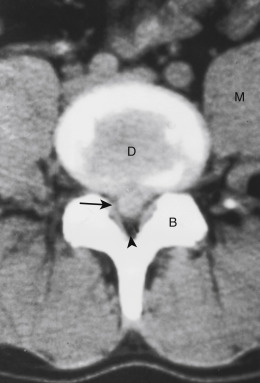
Become a Clinical Tree membership for Full access and enjoy Unlimited articles
If you are a member. Log in here